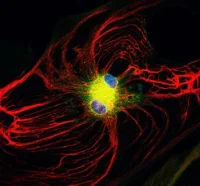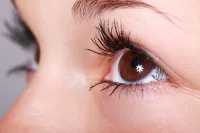Bionic Exoskeleton designed by Ekso Bionics. (Image courtesy of Ekso Bionics.)
Ekso Bionics™ announced on July 8, 2013, the availability of a new feature of the Ekso ™ bionic suit which enables individuals with lower extremity paralysis or weakness to stand and walk. The addition of Variable Assist now provide s the ability for clinicians to augment their patients’ strength b y tuning the amount of power contributed to help an individual’s walking efforts for either leg ; thereby adding to the suit’s utility for patients with hemiparesis due to stroke, incomplete spinal cord injury , or other neurological injuries or conditions .
Ekso is a robotic exoskeleton which enables individuals with lower extremity paralysis to stand up and walk over ground with a weight bearing, reciprocal gait. Battery - powered motors drive the legs and replace neuromuscular function. The Variable Assist feature works by allowing individuals with any amount of lower extremity strength to contribute their own power - from either leg - to achieve walking over ground. The addition of Variable Assist to the Ekso suit allows therapists to treat a wider range of clinical presentations and to explore the effects of various interventions by tuning the power contribution to either of the patient’s legs.
Ekso with Variable Assist is a functional - based platform designed to help patients relearn proper gait patterns and weight shifts, and to facilitate high step dosage. Based on the therapeutic goals, therapists now have the option to assign a specific amount of power contribution to augment their patients’ efforts, or to allow the Ekso suit to dynamically adjust to their needs in real - time . For example, the clinician may assign a higher power contribution to produce a more naturalized gait, or less power contribution to challenge the patient’s walking efforts. This encourages patients t o actively contribute to their recovery process and helps the therapist challenge patients with progressive rehabilitation.
“Since we delivered the first device to Craig Hospital last year, Ekso has helped over 1 thousand individuals take over 3 million steps that would not have otherwise been possible ,” said Nathan Harding, co-founder and CEO of Ekso Bionics. “We are incredibly excited that w ith the addition of this new feature , w e now have the potential to help million s of stroke survivors to walk again too. ”
The Ekso suit can be found in leading rehabilitation clinics across North America, Europe, and Africa.
Source: Esko Bionics
Variable Assist Feature Offers Benefits for Patients Recovering from Such Neurological Conditions as Stroke
Ekso Bionics™ announced on July 8, 2013, the availability of a new feature of the Ekso ™ bionic suit which enables individuals with lower extremity paralysis or weakness to stand and walk. The addition of Variable Assist now provide s the ability for clinicians to augment their patients’ strength b y tuning the amount of power contributed to help an individual’s walking efforts for either leg ; thereby adding to the suit’s utility for patients with hemiparesis due to stroke, incomplete spinal cord injury , or other neurological injuries or conditions .
Ekso is a robotic exoskeleton which enables individuals with lower extremity paralysis to stand up and walk over ground with a weight bearing, reciprocal gait. Battery - powered motors drive the legs and replace neuromuscular function. The Variable Assist feature works by allowing individuals with any amount of lower extremity strength to contribute their own power - from either leg - to achieve walking over ground. The addition of Variable Assist to the Ekso suit allows therapists to treat a wider range of clinical presentations and to explore the effects of various interventions by tuning the power contribution to either of the patient’s legs.
Ekso with Variable Assist is a functional - based platform designed to help patients relearn proper gait patterns and weight shifts, and to facilitate high step dosage. Based on the therapeutic goals, therapists now have the option to assign a specific amount of power contribution to augment their patients’ efforts, or to allow the Ekso suit to dynamically adjust to their needs in real - time . For example, the clinician may assign a higher power contribution to produce a more naturalized gait, or less power contribution to challenge the patient’s walking efforts. This encourages patients t o actively contribute to their recovery process and helps the therapist challenge patients with progressive rehabilitation.
“Since we delivered the first device to Craig Hospital last year, Ekso has helped over 1 thousand individuals take over 3 million steps that would not have otherwise been possible ,” said Nathan Harding, co-founder and CEO of Ekso Bionics. “We are incredibly excited that w ith the addition of this new feature , w e now have the potential to help million s of stroke survivors to walk again too. ”
The Ekso suit can be found in leading rehabilitation clinics across North America, Europe, and Africa.
Source: Esko Bionics
Latest Articles
Stroke, rehabilitation
Bionic Exoskeleton designed by Ekso Bionics. (Image courtesy of Ekso Bionics.) Variable Assist Feature Offers Benefits for Patients Recovering from Such N...










